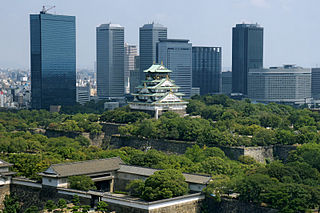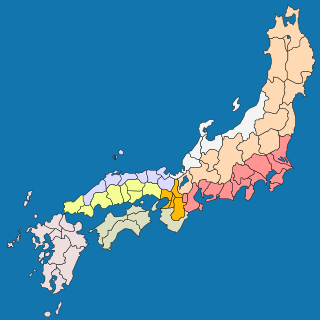
Kyoto, officially Kyoto City, is the capital city of Kyoto Prefecture in the Kansai region of Japan's largest and most populous island of Honshu. As of 2020, the city had a population of 1.46 million, making it the ninth-most populous city in Japan. More than half (56.8%) of Kyoto Prefecture's population resides in the city. The city is the cultural anchor of the substantially larger Greater Kyoto, a metropolitan statistical area (MSA) home to a census-estimated 3.8 million people. It is also part of the even larger Keihanshin metropolitan area, along with Osaka and Kobe.

Osaka is a designated city in the Kansai region of Honshu in Japan. It is the capital of and most populous city in Osaka Prefecture, and the third-most populous city in Japan, following the special wards of Tokyo and Yokohama. With a population of 2.7 million in the 2020 census, it is also the largest component of the Keihanshin Metropolitan Area, which is the second-largest metropolitan area in Japan and the 10th-largest urban area in the world with more than 19 million inhabitants.

The Tokugawa shogunate, also known as the Edo shogunate, was the military government of Japan during the Edo period from 1603 to 1868.

The Nara period of the history of Japan covers the years from 710 to 794. Empress Genmei established the capital of Heijō-kyō. Except for a five-year period (740–745), when the capital was briefly moved again, it remained the capital of Japanese civilization until Emperor Kanmu established a new capital, Nagaoka-kyō, in 784, before moving to Heian-kyō, modern Kyoto, a decade later in 794.

Tokyo City was a municipality in Japan and capital of Tokyo Prefecture which existed from 1 May 1889 until the establishment of Tokyo Metropolis on 1 July 1943. The historical boundaries of Tokyo City are now occupied by the special wards of Tokyo. The defunct city and its prefecture became what is now Tokyo, also known as the Tokyo Metropolis or, ambiguously, Tokyo Prefecture.

Ukyō-ku (右京区) is one of the eleven wards in the city of Kyoto, in Kyoto Prefecture, Japan.

Tō-ji Temple, also known as Kyō-ō-gokoku-ji is a Shingon Buddhist temple in the Minami-ku ward of Kyoto, Japan.

Kamigyō-ku is one of the eleven wards in the city of Kyoto, in Kyoto Prefecture, Japan. The ward was a district of residences for the royalty, aristocrats, and upper classes in the old capital of JapanーHeian-kyō. Located in the center of the present-day city of Kyoto, Japan, it previously occupied the northern region of the ancient capital of Kyoto. The Kamo River flows on the eastern border of the ward.

Sakyō-ku is one of the eleven wards in the city of Kyoto, in Kyoto Prefecture, Japan. It is located in the northeastern part of the city.

Kōdai-in (高台院), formerly known as Nene (ねね), One (おね), Nei (ねい), was an aristocrat and Buddhist nun, founder of the temple Kōdai-ji in Kyoto, Japan. She was formerly the principal samurai wife of Toyotomi Hideyoshi under the name of Toyotomi Yoshiko. When she rose in higher political status, she took the title of "Kita no mandokoro". As the matriarch figure of the Toyotomi clan, she led all diplomatic affairs that had to do with the imperial court, and monitored the daimyos' families who were being held hostage at Osaka Castle.

Heian-kyō(平安京, lit. "peaceful/tranquil capital") was one of several former names for the city now known as Kyoto. It was the official capital of Japan for over one thousand years, from 794 to 1868 with an interruption in 1180.
The following is a timeline of the history of the city of Atlanta, Georgia, United States.
The following is a timeline of the history of the city of Osaka, Japan.
The following is a timeline of the history of the city of Yokohama, Japan.
The following is a timeline of the history of the city of Nagasaki, Japan.
The following is a timeline of the history of the city of Kobe, Japan.
The following is a timeline of the history of the city of Nagoya, Japan.
The following is a timeline of the history of Fukuoka City, Japan.
The following is a timeline of the history of the city of Hiroshima, Japan.
The following is a timeline of the history of Tokyo, Japan.












